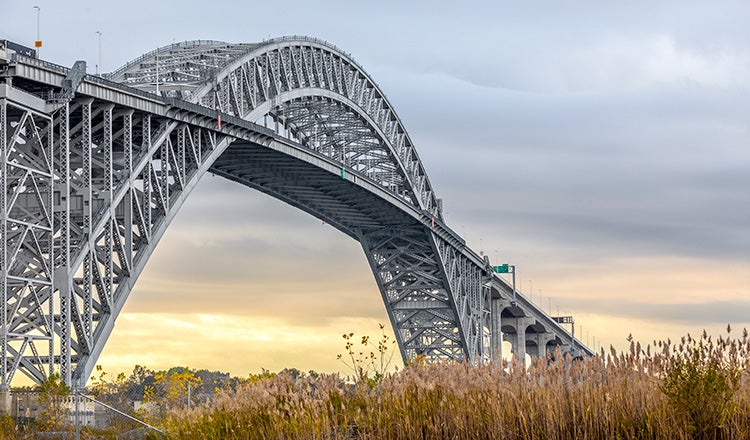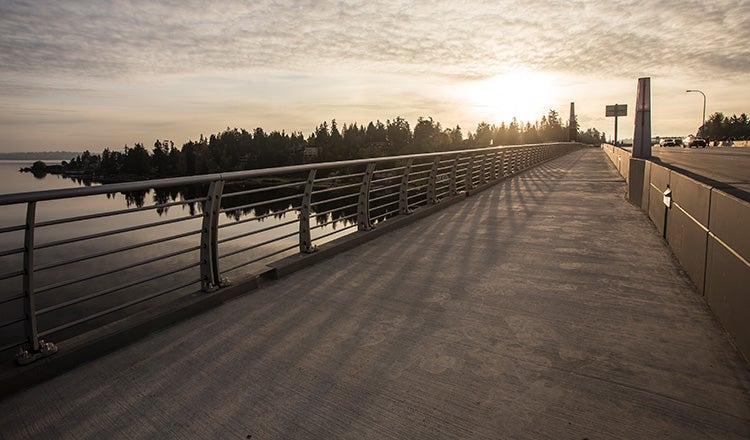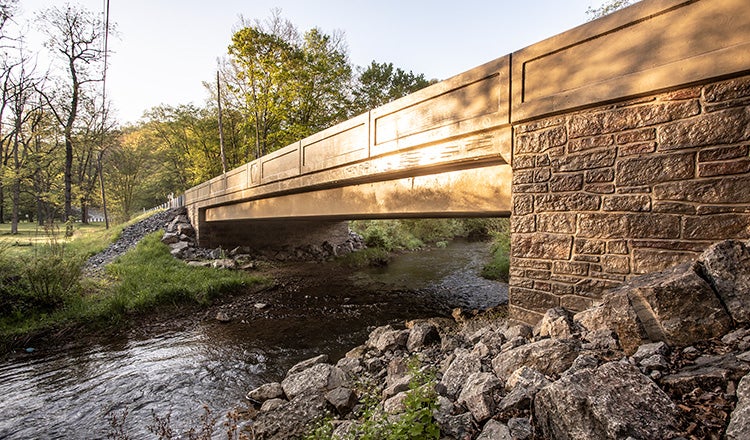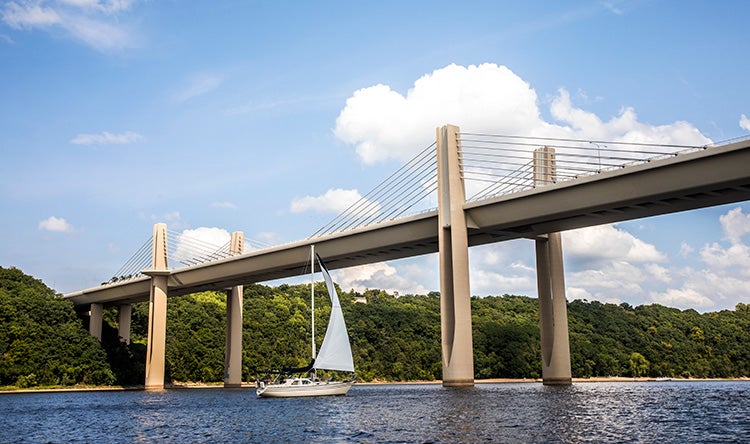
Experts Talk: Sustainable Bridge Design with Rob Richardson and Don Nguyen
Experts Talk is an interview series with technical leaders from across our transportation program.
How to Incorporate Sustainability Into Bridge Design, Starting With Planning

As communities are looking for ways to be more sustainable, and an influx of federal infrastructure funding that includes new sustainability requirements, now is a good time to look at bridges. From planning to concrete selection, sustainability can be incorporated into the bridge planning process. Our bridge experts have been at the forefront of sustainable bridge design, and they know how to apply best practices to all kinds of bridges.

Rob Richardson, P.E., ENV SP, is our West region bridge leader and past bridge and structures sustainability program leader. He has 30 years of experience in project delivery of all phases from early planning to final plans and specifications. He believes that sustainable bridge practices begin during the planning stages.
Don Nguyen, P.E., SE, ENV SP, STP, is our bridges and structures sustainability program leader. He has experience in project management, design, analysis, construction services, specifications, and inspections. He has the technical expertise to help clients determine the best way to incorporate sustainability in bridge design, from small to signature bridges.
Q. Why are agencies increasingly looking at sustainability when building bridges?
Nguyen: In the United States, the recent $1.2 trillion bipartisan infrastructure law includes a new focus on sustainable and resilient communities. So one short answer: Funding. To access this influx of federal funds, owners must be more cognisant of the sustainability and resiliency of their new and existing infrastructure.
Though there is money coming to states and localities now, the funding is not unlimited. One way to be good stewards of taxpayer dollars is to design sustainable structures, making the most efficient use of the money allocated. By designing structures with the entire life cycle in mind, as well as maintaining existing structures before they dilapidate to the point of no return, we can extend their usable life. Designing a bridge with sustainability in mind can increase the initial cost of new structures in some cases but can save money in the long term.
Richardson: As a society, we should constantly be looking for ways to enhance the sustainability of our infrastructure. The natural resources we have to work with are limited.
In many ways, the construction of bridges has always included elements that are now considered sustainable. For example, bridge design codes require a minimum 75-year design life, and specifications for concrete mix designs make use of waste products like blast furnace slag and fly ash that would otherwise end up in a landfill. Bridges also utilise a significant amount of steel, either structural steel or reinforcing bars, largely made from recycled steel.
But now many owners are looking to go further, sometimes spurred by increasing public interest in sustainable practices. At the agency level, effective leadership and a strong commitment to reaching sustainability goals will help an organisation move toward sustainable design.
This effort must engage the entire team, including lead designers, in the project development. To build a truly sustainable bridge, the team must think about its lifespan from conception to decommissioning, and consider social equity and justice, as well as the protection of natural resources and addressing climate change through resilient design.

Q. What makes a bridge sustainable?
Richardson: A sustainable bridge should address all the aspects associated with the broad term “sustainability,” and that starts with asking, “Is this the right project?”
Some questions to ask yourself as you’re conceiving a bridge project:
- Has the alignment been coordinated with structural needs to minimise impact?
- If we change the span length or arrangements, how much could we reduce the impact to a greenfield?
- Are we connecting communities or dividing them with our structure?
This last question can come into play a lot when we consider using retained fill instead of bridges to reduce construction costs. Yes, it might be cheaper in the short term, but it also creates a visual and physical barrier that could have detrimental effects to a community in a way that a bridge that’s open underneath would not.
I would like to see more bridge engineers involved in projects earlier — in the planning phase — to answer questions like these and help the right project move ahead to design.
Nguyen: Once a project is identified, the three E’s can help make it as sustainable as possible: economy, ecology and equity. True sustainability is achieved by balancing all three. Sustainable practices can reduce overall cost, protect the natural and built environment, as well as support local communities.
The SR 520 Bridge Replacement Project is a good example of this. The old floating structures were reused elsewhere for docks, artificial reefs and wharves. The new floating structures were designed to treat water runoff on site, within the pontoons. The bridge includes a multi-use path for pedestrian and bicycle use, and it also supports future light rail transit expansion. The program considered both historic resources as well as connections to Native American tribes in the planning phases.

Some more things to consider for your projects include:
- Using recycled materials
- Diverting waste
- Sourcing materials locally
- Using alternative fuels during construction
- Social equity
- Sourcing local labour
- Using materials with a longer service life such as rebar alloys and carbon fiber
Q. How can we reduce the carbon footprint of a bridge?
Richardson: The biggest contributors to a bridge’s carbon footprint are the cement and steel.
It takes significant energy to create Portland cement (the main ingredient in concrete), as well as structural steel and reinforcing bars. There is a lot of research being conducted into cement replacement options that require less energy to produce, such as Portland limestone cement, or PLC, that has recently been accepted by Caltrans. There is also a lot of research on concrete durability, aiming for less cracking and deterioration to help bridges maintain their serviceability well beyond the basic design life we currently expect.
More agencies are accepting the use of high strength steel in girders and reinforcing bars. The high strength options don’t require significantly more energy to create, and we can use less of them which means less use of material and less material to haul to the job sites.
Nguyen: Additionally, the aggregate selection for concrete can also be a source of embodied carbon reduction. Rather than using virgin aggregate, you can use alternatives such as recycled, crushed concrete (even better if it’s made from the bridge you’re replacing) or new, innovative materials that mineralise sequestered carbon dioxide like Blue Planet’s aggregate. Alternatively, CarbonCure is a new technology that injects CO2 directly during the concrete mixing stage. Applying these different options will help move towards a net zero carbon footprint.
Besides concrete, you can look at the entire project using a life cycle assessment to examine all sources of embodied carbon. A good balance of cut and fill of site material reduces the need for hauling. Supporting carpool lanes, transit or multi-modal usage reduces operational carbon. Discuss with your design team and the community to better understand how the needs and wants of the project can align with sustainable choices.

Q. How should an agency decide to pursue a sustainability certification for a bridge?
Richardson: In the building world, a strongly credentialed LEED structure sets a tone for showing that the owner is serious about addressing climate change and dwindling natural resources. That credential is well known and companies who want to promote the sense that their company shares those values want to rent space in LEED-certified buildings and will often pay a premium to do so.
In the bridge world, similar certifications are becoming more common. Some of the most popular infrastructure sustainability certifications include Envision, Greenroads and INVEST. Just like a LEED building can show that sustainability is important for a business, these infrastructure certifications can show community members that an owner values sustainability.
Also, the federal funding through the new Bipartisan Infrastructure Law requires that projects consider aspects of sustainability including resiliency, greenhouse gas emissions, and equity. Certification on previous projects can show proof of an owner’s commitment and open the door to additional future funding.
Nguyen: Do an initial assessment to see if using a sustainability rating system is right for you and your project. Assessing a recently constructed project can give an owner a baseline sustainability level, and if the bridge fits the certification standards, the owner could even retroactively pursue the rating. For the next project, the owner can consider whether it’s cost-effective to pursue a rating and gauge the level of community support. This assessment also might help identify low hanging fruit actions to quickly elevate sustainability levels and reach goals. If not everyone on the project team is up to date on this hot topic, consider doing a boot camp training to get everyone up to speed.
Even if you don’t want to officially rate your project, the framework that the rating systems provide can give guidance on sustainability performance and guide decision making. The rating systems provide sustainability metrics for each sustainable design decision so you can see if your decisions will improve, enhance, conserve, or even restore the natural or social system. You can also use it to collaborate between the owners, stakeholders, contractors, designers and community.
Q. How can we build sustainability into the bridge development and delivery life cycle?
Richardson: There is only so much bridge engineers can do from a sustainability perspective once the project hits their desk for development of plans, specifications and estimates. Truly sustainable projects start from the planning phase and it’s important that bridge engineers are a part of that effort on projects where bridges are considered. We, as problem-solving bridge engineers, need to make a concerted effort to keep out of the weeds in the planning phase and focus on larger picture items that work toward that “building the right project” goal. Understanding environmental aspects of a bridge project, including equity and social justice, plays an important role in building a sustainable bridge and goes beyond the structural analysis and design that bridge engineers tend to focus on.
Take the opportunity to step outside of the structural design comfort zone and consider how the community might be affected by the project — both positively and negatively — to help plan a better project.
Nguyen: Innovations and sustainable advancements can more easily emerge using different project delivery methods. Consider the methods that allow for earlier input from the engineers and the contractor. Design-builds and public-private partnerships allow the collaboration needed to find out what works early on and to get buy-in from all parties. When everyone has sustainability in mind, innovative, sustainable solutions can arise.
The St. Croix Crossing project between Minnesota and Wisconsin included co-location of designers with Minnesota Department of Transportation staff at a project office. This collaboration led to innovation in the form of use of an extradosed bridge, which allowed for reduced tower heights compared to a cable stayed bridge and longer spans, thereby reducing the number of towers in the river.

With the Los Angeles International Airport Automated People Mover, a public-private partnership, the owner held early meetings with the entire team. This brought everyone to the same page regarding sustainability and set the team on the right track. The project team is currently striving for an Envision rating.
Inspiration & Advice
Q. How did you get involved in sustainable bridge design?
Richardson: I’d say it started more from a resiliency design perspective, really. I was a student assistant with Caltrans when the Loma Prieta earthquake caused the partial collapse of the Cypress Viaduct in Oakland, California. The destruction and loss of life was very disturbing to me; and it became especially important to me to pursue seismic retrofit and change the way we design bridges to prevent that from ever happening again. Combine that with the fact that I’ve been recycling for as long as I can remember, and I’ve always been the guy who turns out the lights in an empty room, and I couldn’t help being involved with sustainability.
Nguyen: I’ve always been a strong proponent of community involvement. With my involvement with Bridges to Prosperity and the American Society of Civil Engineers, I’ve gotten to help my local community as well as help the community of Seguidules, Panama. Civil engineering is a career that works towards the betterment of society. Applying the lens of sustainability onto that allows me to be even more community focused.
Q. What advice do you have for bridge designers wanting to get involved in sustainable design?
Richardson: First, and foremost — be curious! And then follow through by looking for ways to get involved and learn more. I think most of us became civil engineers/bridge engineers because we wanted to do something to benefit our fellow citizens now and into the future. With that in mind, an understanding of sustainable and resilient design is an absolute must.
Nguyen: You can get started by attending webinars, talking to others in the field, or getting a credential in a sustainability rating system. It all stems from the desire to learn more. Learn about what steps you can take on your own projects to be just a little more sustainable. Develop your own innovative ideas or consider if the latest advancements in technology or innovations in other projects can be applied. Advocate the benefits of sustainable design to your peers and clients to make it more commonplace in our industry.
Each Experts Talk interview illuminates a different aspect of transportation infrastructure planning, design and delivery. Check back regularly to discover new insights from the specialised experts and thought leaders behind our award-winning, full service consulting practice.

